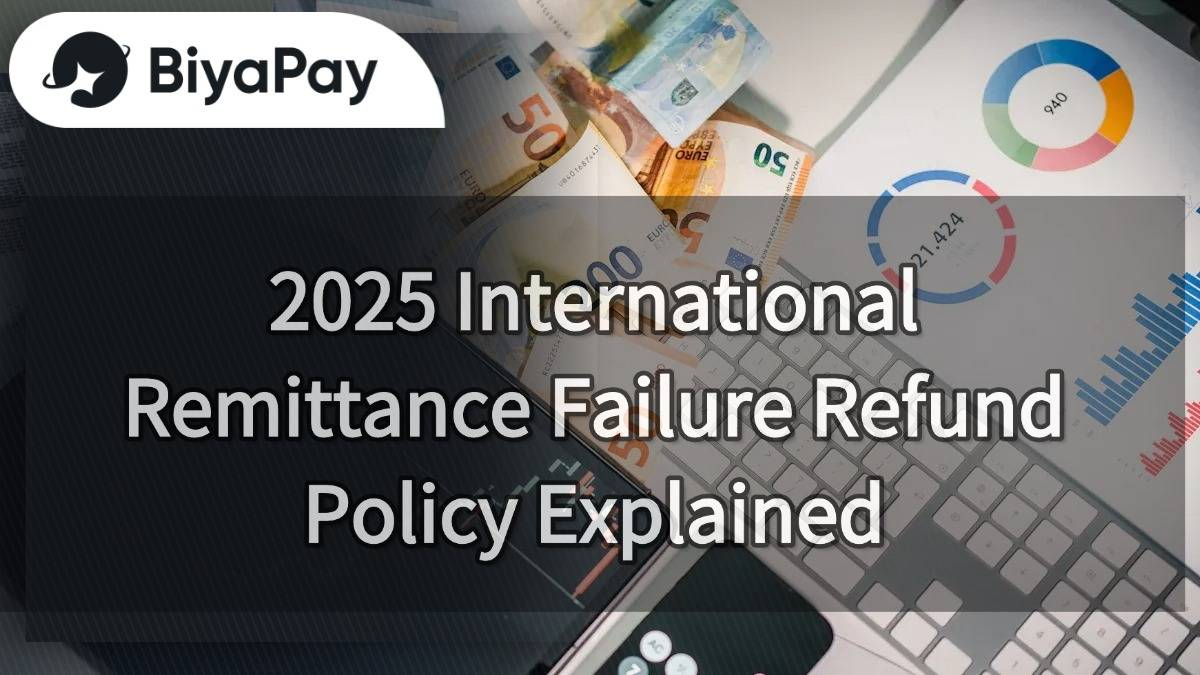- EasyCard
- Trade
- Help
- Announcement
- Academy
- SWIFT Code
- Iban Number
- Referral
- Customer Service
- Blog
- Creator
2025 International Remittance Failure Refund Policy Explained

Image Source: pexels
The 2025 international remittance failure refund policy has undergone significant changes. The new policy outlines specific steps in the refund process and redefines the rules for fee refunds. You will notice that the policy emphasizes transparency, reducing uncertainties in refund applications. For instance, when a remittance fails due to incorrect information or rejection by the recipient bank, refund processing times are faster, and fee refund rules are more reasonable. These changes aim to enhance user experience, making the refund process more seamless.
Reasons for International Remittance Failures

Image Source: pexels
Remittance failures are not uncommon during international transfers. Understanding these reasons can help you mitigate risks and ensure funds reach their destination. Below are common reasons for international remittance failures.
Incorrect Information
Incorrect information is a leading cause of remittance failures. Bank names, addresses, and account numbers must be precise. Even a single letter or digit error can result in a failed transfer. For example, if the recipient’s bank account number is incorrect, funds may be returned, potentially incurring additional fees.
Additionally, the description of the funds’ source and purpose must be clear. Failure to provide accurate proof of funds may lead to the bank rejecting your remittance request. To avoid these issues, thoroughly review all details before submitting your transfer.
Recipient Bank Account Issues
Issues with the recipient’s bank account can also cause remittance failures. For instance, an account may be frozen due to unusual activity. Frequent large transfers or unclear fund sources are often flagged as suspicious, triggering the bank’s risk controls.
Another common issue is exceeding transaction limits. Many financial institutions impose caps on cross-border transfers. If your transfer exceeds this limit, the bank may reject it. To prevent this, verify the recipient bank’s account status and ensure the transfer amount is within permitted limits.
Compliance or Foreign Exchange Policy Restrictions
Failure to pass compliance checks is another major reason for remittance failures. If a bank suspects a transaction is non-compliant or involves suspicious activity, it will reject the transfer. Missing or inadequate documentation can also lead to failures. For example, some countries require additional identity verification or proof of fund purpose. Incomplete or non-compliant documents will prevent the transfer from proceeding.
Foreign exchange policy restrictions are equally critical. Different countries have varying foreign exchange regulations, and some impose strict controls on cross-border fund flows. For instance, China sets clear annual foreign exchange quotas for individuals, and transfers exceeding these limits may be rejected. Before initiating a transfer, research the destination country’s foreign exchange policies to ensure compliance.
Technical or System Issues
Technical or system issues are an often-overlooked cause of remittance failures. You may encounter bank system maintenance or technical glitches that directly impact transfer processing. For example, Hong Kong banks may suspend certain services during system upgrades, causing delays or failures if you submit a transfer during this period.
Network connectivity issues can also lead to failures. Unstable device networks or bank server outages can disrupt transactions. Using a stable network environment can mitigate this risk. Additionally, some remittance platforms may fail to update exchange rates or transaction statuses promptly due to technical issues, delaying fund delivery.
Compatibility issues between payment platforms and bank systems are also noteworthy. If your remittance service provider’s system is incompatible with the recipient bank’s, the transaction may be rejected. For instance, some platforms may not support specific banks’ international transfer protocols. Confirm compatibility with your provider beforehand.
To avoid technical or system issues, consider these steps:
- Choose reliable platforms: Opt for technically robust providers with strong user reviews.
- Monitor bank announcements: Regularly check for system maintenance notices from Hong Kong or other relevant banks to avoid submitting transfers during downtime.
- Ensure stable networks: Use a reliable network when submitting transfer details to minimize failure risks.
These measures can significantly reduce the likelihood of technical or system-related remittance failures, ensuring smooth fund delivery.
Refund Policy Explained
Refund Process
When a remittance fails, you must follow a specific refund process to recover your funds. First, contact your remittance service provider or bank to report the failure. You’ll typically need to provide detailed transaction information, including the transaction ID, transfer amount, and recipient details. Ensure this information is accurate to expedite verification.
The bank will then investigate the failure’s cause. If it’s due to incorrect information or technical issues, the refund process begins immediately. For cases involving compliance or foreign exchange restrictions, additional review time may be required. Track refund progress through the bank’s online support or phone services to stay informed.
To streamline the process, prepare relevant documents in advance, such as transaction receipts or identity proof. These can help the bank verify your identity and transaction details quickly, ensuring a smooth refund application.
Refund Processing Time
Refund processing times vary based on the failure’s cause and bank policies. Typically, refunds for incorrect information or technical issues are completed within 5-7 business days. Failures due to recipient account issues or foreign exchange restrictions may take 10-15 business days.
Hong Kong banks generally process refunds promptly after investigations, but certain cases may require more time. For instance, if the destination bank rejects the funds, coordination between institutions may extend the wait. To avoid delays, confirm the expected processing time when applying for a refund.
If the refund exceeds the expected timeline, proactively contact the bank or provider. Providing additional details can help accelerate the process. Patience and timely communication are key to resolving issues.
Fee Refund Rules
Fee refund rules are a significant update in the 2025 policy. Whether fees are refunded depends on the failure’s cause. If the failure results from bank system issues or technical glitches, fees are typically fully refunded. For failures due to incorrect information or recipient account issues, fees may be partially refunded or not refunded at all.
Hong Kong banks maintain transparent fee refund policies. If the failure is beyond your control, such as foreign exchange restrictions or destination bank rejections, full fee refunds are common. However, if the failure stems from your error, like incorrect details or non-compliance, partial fees may be deducted as processing costs.
To minimize fee losses, double-check all information before transferring and ensure compliance with policies. Choosing reliable providers can also reduce failure risks, saving unnecessary costs.
Special Cases
Destination Bank Rejections
When a destination bank rejects funds, refund processing can become complex. Understanding common rejection reasons can help you address them. Rejections often occur due to abnormal account status, mismatched information, or policy restrictions. For example, the recipient’s account may be closed or frozen, preventing fund crediting.
If this happens, take these steps:
- Contact the recipient: Verify the account’s status. If frozen, the recipient must resolve the issue with their bank.
- Verify transfer details: Ensure account numbers and bank codes are correct.
- Consult the provider: If details are accurate but rejection persists, contact your provider for clarification and assistance.
Patience and proactive communication are crucial when handling destination bank rejections, speeding up the refund process and minimizing delays.
Foreign Exchange Policy Restrictions
Foreign exchange policy restrictions are a common cause of remittance failures. Countries have diverse regulations on foreign fund flows. For example, China imposes strict annual foreign exchange quotas for individuals, and exceeding these can lead to rejections.
To avoid failures due to restrictions, consider these measures:
- Research policies: Check the destination country’s foreign exchange regulations. Hong Kong banks often provide detailed guides via their websites or support teams.
- Split transfers: For large amounts, divide funds into multiple transfers to stay within limits.
- Prepare documents: Some countries require proof of fund source or purpose. Having these ready can improve transaction approval rates.
If a transfer is rejected due to restrictions, contact your bank or provider to understand the specific terms and adjust your plan accordingly. Compliance with regulations reduces failure risks and ensures smooth transfers.
How to Avoid Remittance Failures

Image Source: pexels
Verify Recipient Information
Verifying recipient information is the first step to ensuring a successful transfer. Carefully check details like the recipient’s name, bank account number, and bank code. Even minor spelling errors can prevent funds from arriving.
To enhance accuracy, consider these steps:
- Double-check details: Review all information multiple times before submission.
- Confirm with the recipient: Directly verify account details with the recipient.
- Save records: Store recipient account details securely to avoid errors during repeated entries.
Additionally, ensure the fund purpose description is clear. If the bank requires proof of source or purpose, prepare these documents in advance to avoid delays.
Tip: Stay focused when entering details to avoid errors due to distractions.
Understand Destination Country’s Foreign Exchange Policies
Foreign exchange policies vary by country. Knowing the destination’s regulations can prevent failures due to restrictions. For instance, China’s annual foreign exchange limits for individuals can cause rejections if exceeded.
Here are practical tips:
- Research regulations: Use bank websites or support to understand the destination’s foreign exchange rules.
- Split large transfers: Divide large amounts into smaller transactions to comply with limits.
- Prepare documentation: Have proof of fund source or purpose ready if required.
Note: Foreign exchange policies may change, so stay updated on the latest rules.
Choose Reliable Remittance Providers
Choosing reliable remittance providers significantly boosts transaction success rates. Quality providers reduce errors and assist with compliance, minimizing failures.
Key considerations for selecting providers:
- User reviews: Opt for platforms with strong reputations, like PayPal or Alipay, which are user-friendly for small cross-border transfers.
- Technical reliability: Ensure the provider’s system is stable for quick transactions.
- Compliance support: Choose providers familiar with international remittance regulations to avoid policy-related failures.
Tip: Reliable providers save time and effort, streamlining the transfer process.
By verifying details, understanding policies, and selecting trusted providers, you can significantly reduce remittance failure risks, ensuring secure fund delivery.
Confirm Recipient Account Status in Advance
Confirming the recipient’s account status before transferring is critical. Abnormal account conditions can prevent funds from arriving, leading to refund delays. Pre-transfer communication with the recipient can avoid these issues.
Why Confirm Account Status?
Recipient accounts may be frozen, closed, or exceed transaction limits, causing failures. Hong Kong bank data shows over 20% of remittance failures are linked to account status issues. Confirming status helps identify risks and ensures smooth transactions.
How to Confirm Account Status?
Follow these steps:
- Contact the recipient: Ask if the account is active and free from freezes or closures.
- Verify details: Ensure account numbers and bank codes are accurate.
- Check limits: Confirm the recipient bank’s single or daily transaction limits to avoid exceeding them.
Tip: For large transfers, check with the bank for additional documentation or approval requirements.
Handling Abnormal Account Status
If the recipient’s account has issues, take these actions:
- Advise recipient to contact their bank: Have them resolve freezes or closures.
- Adjust transfer plans: Split transfers if limits are insufficient.
- Use alternate accounts: Switch to another active account if available.
Confirming account status in advance reduces failure risks, saving time and avoiding fee losses.
The 2025 international remittance failure refund policy offers clearer guidance for users. Key points include:
- Incorrect recipient information may delay refunds.
- Unclear fund source or purpose descriptions increase failure risks.
- Abnormal account activity or compliance issues can trigger bank risk controls.
- Foreign exchange restrictions and destination bank rejections are common failure causes.
Verifying details and choosing reliable providers are critical. By checking recipient information, understanding foreign exchange policies, and confirming account status, you can minimize failure risks. Thorough preparation saves time and avoids unnecessary costs.
Tip: Before transferring, ensure all details are accurate and use technically robust platforms for secure fund delivery.
FAQ
1. Will I incur additional fees if a remittance fails?
Fee refunds depend on the failure’s cause. If due to bank system issues or technical glitches, fees are fully refunded. For errors like incorrect details or policy non-compliance, partial fees may be deducted.
Tip: Double-check details before transferring to avoid fee losses.
2. How long does it take to receive a refund after a failed remittance?
Refund times vary by cause. Failures due to incorrect details or technical issues typically take 5-7 business days. Issues involving foreign exchange restrictions or account problems may take 10-15 business days.
Note: Track progress via bank support to stay updated.
3. How can I confirm the recipient’s account status is normal?
Contact the recipient to verify if the account is active and not frozen or closed. Confirm account numbers and bank codes. Check the bank’s transaction limits to avoid exceeding them.
4. What should I do if the destination bank rejects the funds?
First, verify the recipient’s account status. Then, check transfer details for accuracy. If issues persist, contact your provider for clarification and assistance.
Advice: Stay patient and communicate promptly to resolve issues faster.
5. How can I avoid remittance failures?
- Verify recipient details for accuracy.
- Understand the destination’s foreign exchange policies to avoid restrictions.
- Choose reliable providers to minimize technical issues.
- Confirm recipient account status in advance.
Tip: Thorough preparation is key to successful transfers.
International remittances often fail due to incorrect details, account issues, or forex restrictions, with refunds taking 5-15 days and costly bank fees sometimes non-refunded. BiyaPay offers a seamless, affordable solution for global transfers! Exchange over 30 fiat currencies and 200+ cryptocurrencies with real-time rate tracking to minimize cost fluctuations, with fees as low as 0.5% across 190+ countries, delivered same-day. Its user-friendly interface reduces input errors, and a 1-minute BiyaPay signup lets you manage tuition, shopping, or business payments effortlessly, secured by robust multi-factor verification. Earn a 5.48% annualized yield on flexible savings. Licensed under U.S. MSB and New Zealand FSP, BiyaPay meets global standards. Join BiyaPay today to avoid failures and ensure swift, secure transfers!
*This article is provided for general information purposes and does not constitute legal, tax or other professional advice from BiyaPay or its subsidiaries and its affiliates, and it is not intended as a substitute for obtaining advice from a financial advisor or any other professional.
We make no representations, warranties or warranties, express or implied, as to the accuracy, completeness or timeliness of the contents of this publication.




Contact Us
Company and Team
BiyaPay Products
Customer Services
is a broker-dealer registered with the U.S. Securities and Exchange Commission (SEC) (No.: 802-127417), member of the Financial Industry Regulatory Authority (FINRA) (CRD: 325027), member of the Securities Investor Protection Corporation (SIPC), and regulated by FINRA and SEC.
registered with the US Financial Crimes Enforcement Network (FinCEN), as a Money Services Business (MSB), registration number: 31000218637349, and regulated by FinCEN.
registered as Financial Service Provider (FSP number: FSP1007221) in New Zealand, and is a member of the Financial Dispute Resolution Scheme, a New Zealand independent dispute resolution service provider.




















